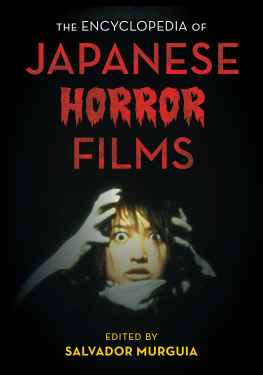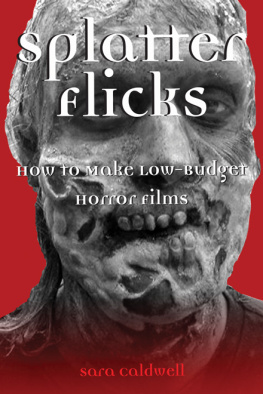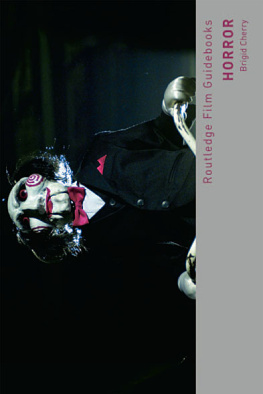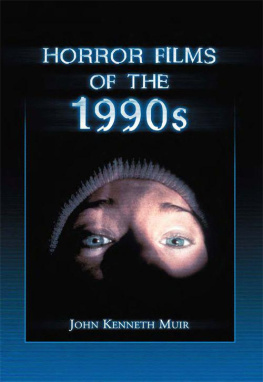Anthem Press
An imprint of Wimbledon Publishing Company
www.anthempress.com
This edition first published in UK and USA 2012
by ANTHEM PRESS
75-76 Blackfriars Road, London SE1 8HA, UK
or PO Box 9779, London SW19 7ZG, UK
and
244 Madison Ave. #116, New York, NY 10016, USA
Copyright Bruce F. Kawin 2012
The author asserts the moral right to be identified as the author of this work.
Cover image 1931 Universal Pictures Corp. All rights reserved.
From the library of the Academy of Motion Picture Arts and Sciences.
All rights reserved. Without limiting the rights under copyright reserved above,
no part of this publication may be reproduced, stored or introduced into
a retrieval system, or transmitted, in any form or by any means(electronic, mechanical, photocopying, recording or otherwise),
without the prior written permission of both the copyright
owner and the above publisher of this book.
British Library Cataloguing-in-Publication Data
A catalogue record for this book is available from the British Library.
Library of Congress Cataloging-in-Publication Data
Kawin, Bruce F., 1945
Horror and the horror film / Bruce F. Kawin.
p. cm. (New perspectives on world cinema)
Includes bibliographical references and index.
ISBN 978-0-85728-450-1 (pbk. : alk. paper) ISBN 978-0-85728-449-5 (hardback : alk. paper)
1. Horror filmsHistory and criticism. I. Title.
PN1995.9.H6K39 2012
791.436164dc23
2012016159
ISBN-13: 978 0 85728 449 5 (Hbk)
ISBN-10: 0 85728 449 5 (Hbk)
ISBN-13: 978 0 85728 450 1 (Pbk)
ISBN-10: 0 85728 450 9 (Pbk)
This title is also available as an eBook.
This ebook was produced with http://pressbooks.com.
New Perspectives on World Cinema
The New Perspectives on World Cinema series publishes engagingly written, highly accessible, and extremely useful books for the educated reader and the student as well as the scholar. Volumes in this series will fall under one of the following categories: monographs on neglected films and filmmakers; classic as
well as contemporary film scripts; collections of the best previously published criticism (including substantial reviews and interviews) on single films or filmmakers; translations into English of the best classic and contemporary film theory; reference works on relatively neglected areas in film studies, such as production design (including sets, costumes, and make-up), music, editing, and cinematography; and reference works on the relationship between film and the other performing arts (including theater, dance, opera, etc.). Many of our titles will be suitable for use as primary or supplementary course texts at undergraduate and graduate levels. The goal of the series is thus not only to address subject areas in which
adequate classroom texts are lacking, but also to open up additional avenues for film research, theoretical speculation, and practical criticism.
Series Editors
Wheeler Winston Dixon University of Nebraska, Lincoln, USA
Gwendolyn Audrey Foster University of Nebraska, Lincoln, USA
Editorial Board
David Sterritt Columbia University, USA
Valrie K. Orlando University of Maryland, USA
Thomas Cripps Morgan State University, USA
Robert Shail University of Wales Lampeter, UK
Catherine Fowler University of Otago, New Zealand
Andrew Horton University of Oklahoma, USA
Frank P. Tomasulo City College of New York, USA
The night can sweat with terror as before
We pieced our thoughts into philosophy
W. B. Yeats, Nineteen Hundred and Nineteen
Preface
I have a blood disorder similar to hemophilia, and my father was a hunchback. I came to the horror film naturally. I thought it addressed the terms of my real world as well as my imagination. It seemed to me that in a horror film anything could happen, anything could be dreamt of and shown, while all the other movies were stuck in the known world.
I was scared of a lot of things, and a horror film calmed me. Im still afraid of excessive bleeding and I rememberor more exactly, cant forgetvomiting spaghetti-like balls of clots after my tonsils were removed, and a doctor using big forceps to snip off the scabs that were closing my throat as the thick blood built up beneath them. As hands or matched parts fit together, the horror film met my fears with its world full of fear. It offered an alternative and a complement to anxiety with its made-up anxiety. It lived up to the energy inside me. Sometimes it scared methe first mummy film I saw, Pharaohs Curse, gave me bad nightmares at 11, but I still enjoyed it. The thrills and visions, especially the look of a new monster, compensated for the risk of nightmares. They were by far my favorite movies, and this book attempts to convey a mature appreciation for them along with a comprehensive view of their values, their narrative strategies, their artistic achievements, their relations to reality and fantasy and their claims to profundity and cinematic power.
The horror film is a construct of fear and revulsion, and this vivid, sometimes gruesome book examines the frightful and disgusting in the clearest possible terms. These observations are based on close viewings of the films, and not on what has been written about them. The films are the key data here; this is not a survey of horror criticism and theory, although relevant earlier work is of course acknowledged. Instead it is a fresh, comprehensive look at how the horror film frightens, disturbs, shocks and revolts the viewer, the effect and the art of it and some of the good that comes from it.
The book begins with an overall look at the genre, an introduction to the horror experience and some recurring ways it has been structured in cinema. The book then examines the subgenres of the horror film, each one organized by the brand of horror central to it, which is most often embodied in a monster: hence the sub-subgenre of the vampire movie within the subgenre of the supernatural monster movie. This taxonomy proves to be a clear and simple way to organize the whole genre, and to cover many key films across its history, all the way from A Terrible Night (1896) to Scream 4 (2011). At the end, there is an added discussion of two closely related genres that have the ability to integrate horror into their worldviewsthat is, the comedy and the documentary. I have designed this to be a complete description of the horror film, although there will always be new monsters and threats. This book is addressed to horror enthusiasts, to film scholars and to general readers who have yet to be convinced of the importance of the genre.
I am very grateful to those who read earlier drafts of my book: Rick Balkin, Ann R. Cacoullos, Christina Dokou, Katherine Eggert, David Glimp, Lori Janssen, Stephen Graham Jones, Lise Menn, Wayne Phillips, Cathy Preston, Michael Preston and Harold Schechter.
Boulder, Colorado
December 2011
List of Figures
Figure 1The Texas Chain Saw Massacre: Looking at horror.










